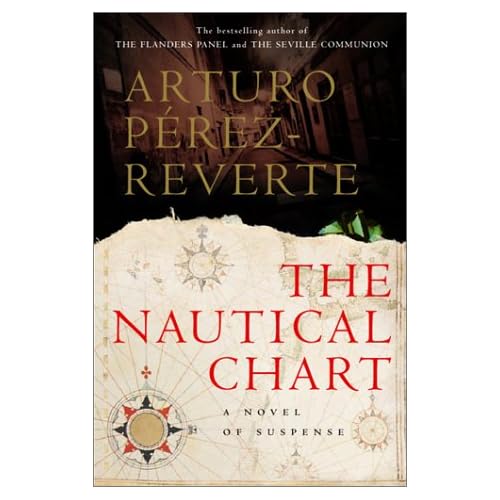
Book Review: The Nautical Chart
Editor Note: A younger Martin wrote this review about 15 years ago. The tone is different as is the voice he generally uses on WWTFT, however, rest assured, it’s him. He rescued this from his personal archives because he remembers really liking this book.
This is another book I rescued from my dad’s library consolidation efforts. I picked it up at the time because of the heft and presentation of the physical volume. I hate to bury the lead too deeply, so first and foremost (almost) I’ll tell you that I give this book 4.5 stars out of 5. But, because I was so enamored with the physical, tangible aspects of the publisher’s work (Harcourt) I have to spend some time on that.
 The Nautical Chart edition that I read was a hard-back of 466 pages. It is the first US edition printed in 2000, set in MT Dante typeface. This book’s quality knocked my socks off. It was just the happy confluence of the perfect form factor, beautifully cut pages, heavy paper, glossy dust jacket/cover, and easy to read type. Just looking at the book and picking it up, feeling its solid heft and quality, made me want to read it. The title caught my eye, among the thousands of others (yes, literally thousands) that I perused before shipping them all off to variety of book sellers.
The Nautical Chart edition that I read was a hard-back of 466 pages. It is the first US edition printed in 2000, set in MT Dante typeface. This book’s quality knocked my socks off. It was just the happy confluence of the perfect form factor, beautifully cut pages, heavy paper, glossy dust jacket/cover, and easy to read type. Just looking at the book and picking it up, feeling its solid heft and quality, made me want to read it. The title caught my eye, among the thousands of others (yes, literally thousands) that I perused before shipping them all off to variety of book sellers.
Normally, I don’t pay a lot of attention to the binding, format hard/soft, or even the condition of book. I’ve read books that are falling apart and smell of mold. Half of the C.S. Forrester Hornblower series were paperback copies that were dry and brittle, literally coming apart at the seams. I didn’t care about yellowing pages, I just wanted to read the contents and enjoy the story. This book however, really wowed me. It’s just plain nice.
OK, so enough on the paper, binding, and artwork. On to a review of the book itself.
The Nautical Chart is the first book I have read by its author, Arturo Perez-Reverte. (But it won’t be the last – more on that later.) I thoroughly enjoyed this book. Perez-Reverte is a Spanish author and this book was obviously a translation. However, I found it to be well-done. It didn’t read like a translation. Yet, the language was able to convey a sense of Latin romanticism on the part of it’s protagonists and antagonists.
I liked all the characters – good guys and bad. I liked the writing. I liked the setting (modern day Spain and mid 18th Century). Prior to writing this review, I did something I never do prior to jotting down my own thoughts on a book. I read some of the reviews on Amazon. They were widely divergent. Some readers said it wasn’t the writer’s best effort! Some complained of the translation. Others complained about the use of nautical terms and jargon (didn’t bother me any.) Of course a lot of people really liked it, too. You can put me in that group.
It is kind of a melancholy tale of adventure and the tragic relationship between the hero and the lady of the story. The author definitely illustrates a culture where men are men and women are creatures of beauty and mystery. Here is an example of the internal musings of his hero, a down on his luck merchant seaman:
Terra Firma, he concluded after long deliberation, was nothing more than a vast conspiracy determined to harass the sailor. It had underwater peaks that didn’t show on the charts, and reefs, sandbars, and capes with treacherous shoals; and besides, it was peopled by a multitude of officials, customs officers, shipowners, port captains, police, judges, and women with freckles. (The lady of the story is an exotic woman with freckles, which are an endless source of fasciation and speculation to the hero.)
In addition to delightful prose, there are lots of references to things that I had never heard of; books, comics, historical figures, and events. I had never heard of Tintin, for example. Neither was I familiar with the Alexandria Quartet. There were others that I had read, of course, like Joseph Conrad and Melville. These and other literary allusions served to make the book even more interesting to me. Similarly, the historical references to Jesuits in Spain have also piqued my interest. I have now run across the love-hate relationship between Catholicism in general, and Spain in a couple of recent reads. The historical intrigue surrounding the Jesuits plays a central role in the story. I have made a mental note to read more about that.
I don’t go out of my way to read mysteries, per se. However, some folks have labeled this book as a mystery. I’m not sure I would classify it as such. It was a suspenseful novel and I didn’t see the end coming. Maybe I’m just easily surprised. I am a little troubled by the reviews I read which harshly critiqued the character development and writing. It’s entirely possible that I’m just not all that sophisticated in my literary tastes.
Nevertheless, I really enjoyed this book from just about all angles. So much so, in fact that I went on-line and ordered two more by the author! I made sure that The Fencing Master and The Seville Communion were both Harcourt hard-cover editions! (These are surprisingly inexpensive through Amazon partners).
 The posts are coming!
The posts are coming!


0 comments
Kick things off by filling out the form below.
Leave a Comment